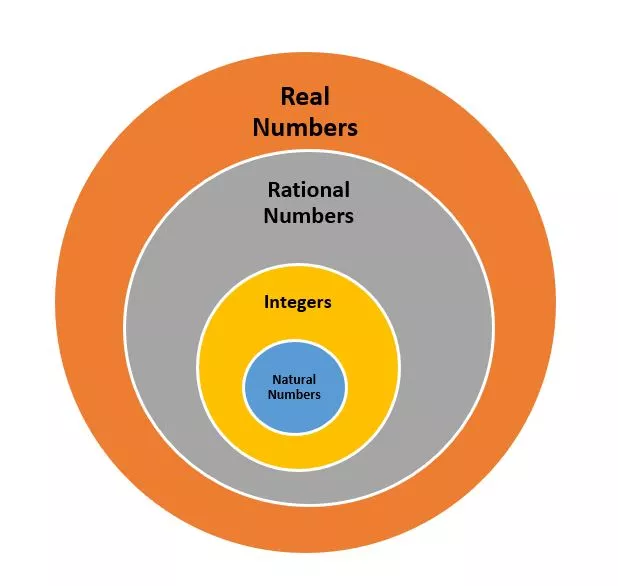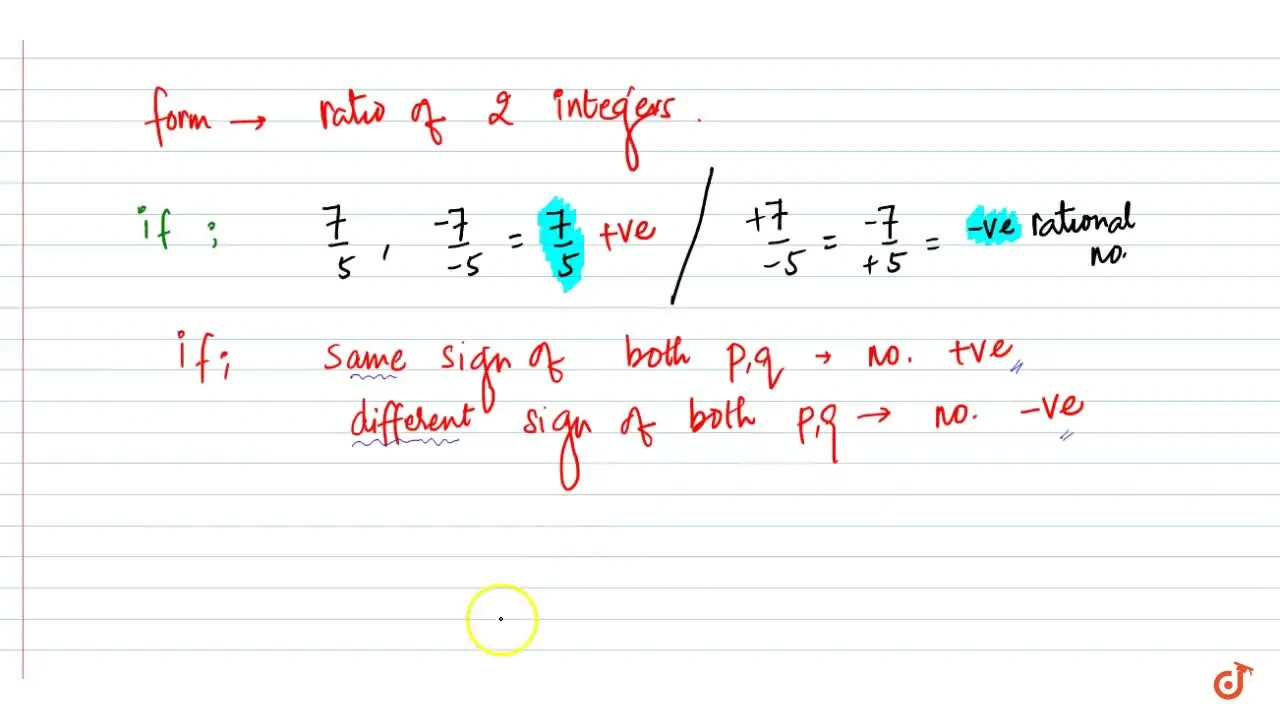What is Rational Number?
Rational Number
The rational numbers are written in p/q form where q is not equivalent to zero. A fraction that has non-zero denominator is considered to be a rational number. Henceforth, we can say that '0' is also a rational number, as we can represent it in numerous forms such as 0/1, 0/2, 0/3, and so on. In any case, 1/0, 2/0, 3/0, and so on are not rational.
In this article, we will focus on the properties of rational numbers alongside with its types. We will also look at the differences between the rational and irrational numbers. For a better understanding, there are some solved examples. Also, get familiar with the various rational numbers examples and figure out how to locate the rational numbers in a superior manner. To indicate rational numbers on a number line, we have to solve and reduce it in the decimal form first.
What is a Rational Number?
A rational number is a number which can be expressed or written in the form of p/q, where q is not equal to zero. The fractions where denominator and numerator are integers, and the denominator is not equivalent to zero, are considered to be rational numbers. The rational numbers include positive, negative numbers, and zero, and they can be expressed as a fraction.
Identification of Rational Numbers
A rational number can be identified by applying the following conditions:
- It is written in the form of p/q, where q is not equal to zero ‘0’.
- The fraction p/q can be simplified and written in decimal form to locate it on the number line.
Examples of Rational Numbers:
p
q
p/q
Rational/Irrational Number
8
5
8/5
Rational
33
11
33/11 = 3
Rational
5
0
5/0
Irrational (since q=0)
2
10
2/10=1/5=0.2
Rational
What are the types of Rational Numbers?
A rational number is a number that can be written in the form of p/q, and both p and q are integers. (i.e. non- zero).
Below Venn diagram explains about different number sets of the number system.

- Real numbers comprise of all the rational numbers.
- Rational numbers include all the integers.
- Integers include all the natural numbers .
- All whole numbers are rational numbers since whole numbers can be expressed as a fraction.
Positive and Negative Rational Numbers
Positive Rational Numbers
Negative Rational Numbers
If the fraction has the numerator and denominator of same signs.
If the fraction has the numerator and denominator of different signs.
These numbers have value greater than zero ‘0’
These numbers have value less than zero ‘0’.
Example: 2/5, 8/10 and 12/17 are positive rational numbers
Example: -5/16, 8/-13 and -2/7 are negative rational numbers
Mathematical Operations on Rational Numbers
Here will look at how can we use different arithmetic operations on rational numbers, for instance, p/q and x/y.
Addition: On adding p/q and x/y, we will make their denominator same. Hence, we get (py+qx)/qy.
Example: 3/4 + 5/4 = (3+5)/4 = 8/4 = 2
Subtraction: In the case of subtraction, p/q and x/y, are required to have the same denominator, first, and then proceed with the subtraction.
Example: 1/3 – 5/6 = (2-5)/6 = -3/6 = -1/2
Multiplication: When we multiply two rational numbers, the numerator and denominators are multiplied, respectively. If p/q is multiplied by x/y, then we get (p×x)/(q×y).
Example: 1/3 × 5/6 = (1×5)/(3×6) = 5/18
Division: On diving a rational with another rational number, p/q is divided by x/y, then it is represented as:
(p/q)÷(x/y) = py/qx
Example: 1/3 ÷ 5/6 = (1×6)/(5×3) = 6/15 = 2/5
Rational Numbers Characteristics
Let us look at some features of rational numbers:
- If we multiply, add or subtract two rational numbers, the result will always be a rational number.
- If we divide or multiply the numerator and denominator with the same number, then the value of rational number remains the same
- If we add zero to a rational number, we will get the same rational number as a result.
Related Videos:
- What is number system?
- Decimals
- Zero is a rational number
- Definition and representation of dfferent type of integers
- Rational number as recurring / terminating
- Existence of non rational numbers (irrational no.) and their representation on no. line
Difference between Rational Numbers and Irrational Numbers
Now that we have understood the rational numbers and their properties, we will move forward to study the difference between rational and irrational numbers.
A rational number is a fraction with non-zero denominator. For example, the fraction 3/4 is a rational number because it is read as integer 3 divided by the integer 4. The numbers that are not considered rational numbers are called irrational numbers.
Rational numerals can be either negative, positive or zero. The negative sign is placed either in front or with the numerator for a negative rational number.
An irrational number cannot be represented as a fraction (since it is the property of rational number), but the irrational number can be written with decimal. Irrational numerals have endless non-repeating numbers after the decimal. Some examples of the irrational numbers are:
π = 3.14285…
√3 = 1.7320508…
Solved Examples on Rational Numbers
Example 1: Differentiate the following set of numerals as rational or irrational
60/977, 3/5, √7, 6.
Solution:
As we know, a rational number is a number that can be expressed as a fraction with non-zero denominator.
- 60/977, is a rational number since it can be represented as a fraction.
- 3/5, is also a rational number since it is expressed in a fraction form.
- √7 is an irrational number since its value is 2.645751311…..non-ending, and it cannot be expressed as a fraction.
- 6 is a whole number; therefore, it is a rational number.
Example 2: Determine whether mixed fraction, 3½ is a rational number.
Solution:
On simplification, 3½ becomes 7/2
Here we see that numerator is 7, which is an integer
and the denominator is 2, which is an integer and also not equal to zero.
Therefore, 7/2 is a rational number.
Example 3: Identify whether the following numbers are rational numbers or irrational numbers.
(a) 3.65 (b) 9.1 (c) √ 5 (d) 0.5 (e) 0.03
Solution:
Most of the numbers are in decimal form. So to identify them as a rational or irrational number, we have to convert the decimal form into fraction format.
If the denominator of the fraction is zero, then the number is irrational, and if the denominator of a fraction is non-zero, then it is a rational number.
Decimal Number
Fraction Form
Rational/Irrational Number
3.65
365/100
Rational
9.1
91/10
Rational
√ 5
Not possible
Irrational
0.5
5/10
Rational
0.03
3/100
Rational
Important Chapters:
p
q
p/q
Rational/Irrational Number
8
5
8/5
Rational
33
11
33/11 = 3
Rational
5
0
5/0
Irrational (since q=0)
2
10
2/10=1/5=0.2
Rational

Positive Rational Numbers
Negative Rational Numbers
If the fraction has the numerator and denominator of same signs.
If the fraction has the numerator and denominator of different signs.
These numbers have value greater than zero ‘0’
These numbers have value less than zero ‘0’.
Example: 2/5, 8/10 and 12/17 are positive rational numbers
Example: -5/16, 8/-13 and -2/7 are negative rational numbers
(p/q)÷(x/y) = py/qx
Decimal Number
Fraction Form
Rational/Irrational Number
3.65
365/100
Rational
9.1
91/10
Rational
√ 5
Not possible
Irrational
0.5
5/10
Rational
0.03
3/100
Rational
Similar Questions
What are rational numbers? Give Examples of five positive and five negative rational numbers. Is there any rational number which is neither positive nor negative? Name it.
View SolutionClassification Of Rational Numbers|Rational Numbers (Q)|Question|Key - Points|Properties Of Rational Numbers|Find The Rational Numbers Between Two Rational Numbers|Summary
View SolutionRational Numbers|Equivalent Rational Numbers|Practice Problem 1|Positive And Negative Rational Numbers|Practice Problem 2|Standard Form Of Rational Numbers|Practice Problem 3|Comparison Of Rational Numbers|OMR
View SolutionRepresentation Of Rational Numbers On Number Line|Practice Problem|Negative Rational Numbers On Number Line|Practice Problem
View SolutionThe numerator and the denominator of a rational number are in the ratio 5:7. When 6 is added to both the numerator and denominator, the ratio becomes 4:5. What is the rational number?
View SolutionIf numerator is 2 less than denominator of a rational number and when 1 is subtracted from numerator and denominator both, the rational number in its simplest form is 12 What is the rational number?
View SolutionWhat rational number should be subtracted from the sum 314 and −47 to get 1321
View SolutionWhat rational number should be added to (−37) to get the greatest negative integer ?
View Solution(i) Which rational number is its own additive inverse?
(ii) Is the difference of two rational numbers a rational number?
(iii) Is the addition commutative on rational numbers?
(iv) Is addition associative on rational numbers?
(v) Is subtraction commutative on rational numbers?
(vi) Is subtraction associative on rational numbers?
(vii) What is the negative of a negative rational number?View SolutionWhich of the following is a rational number?
View Solution


